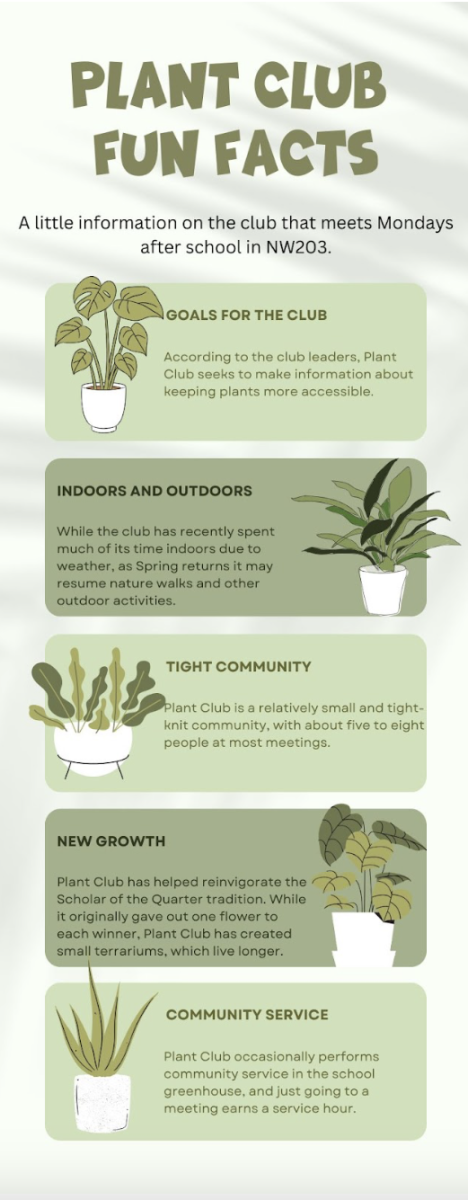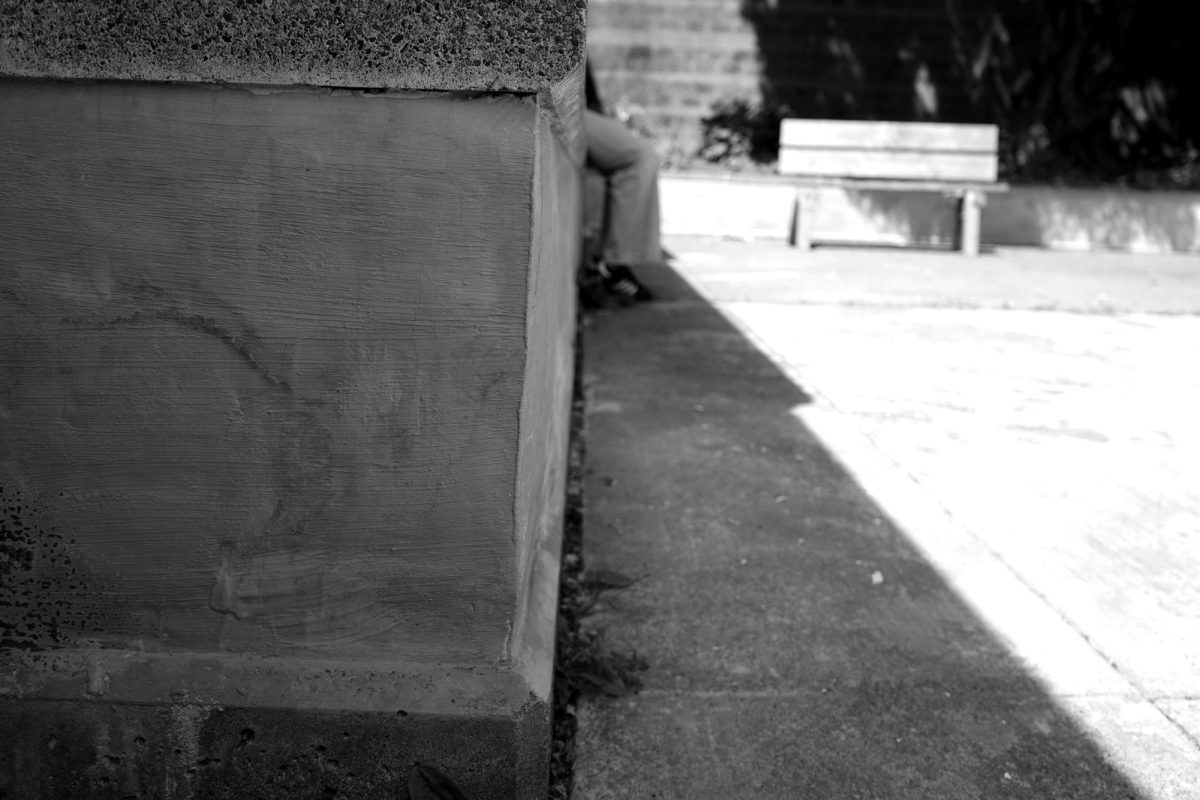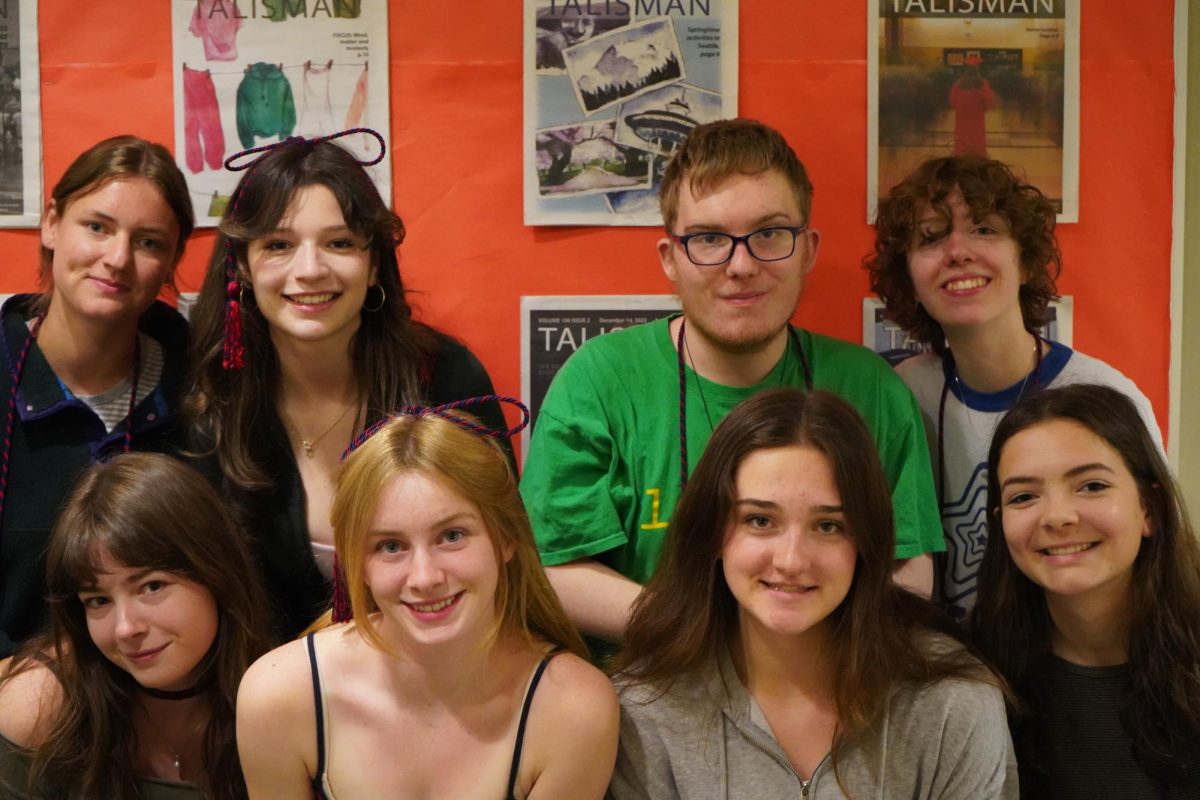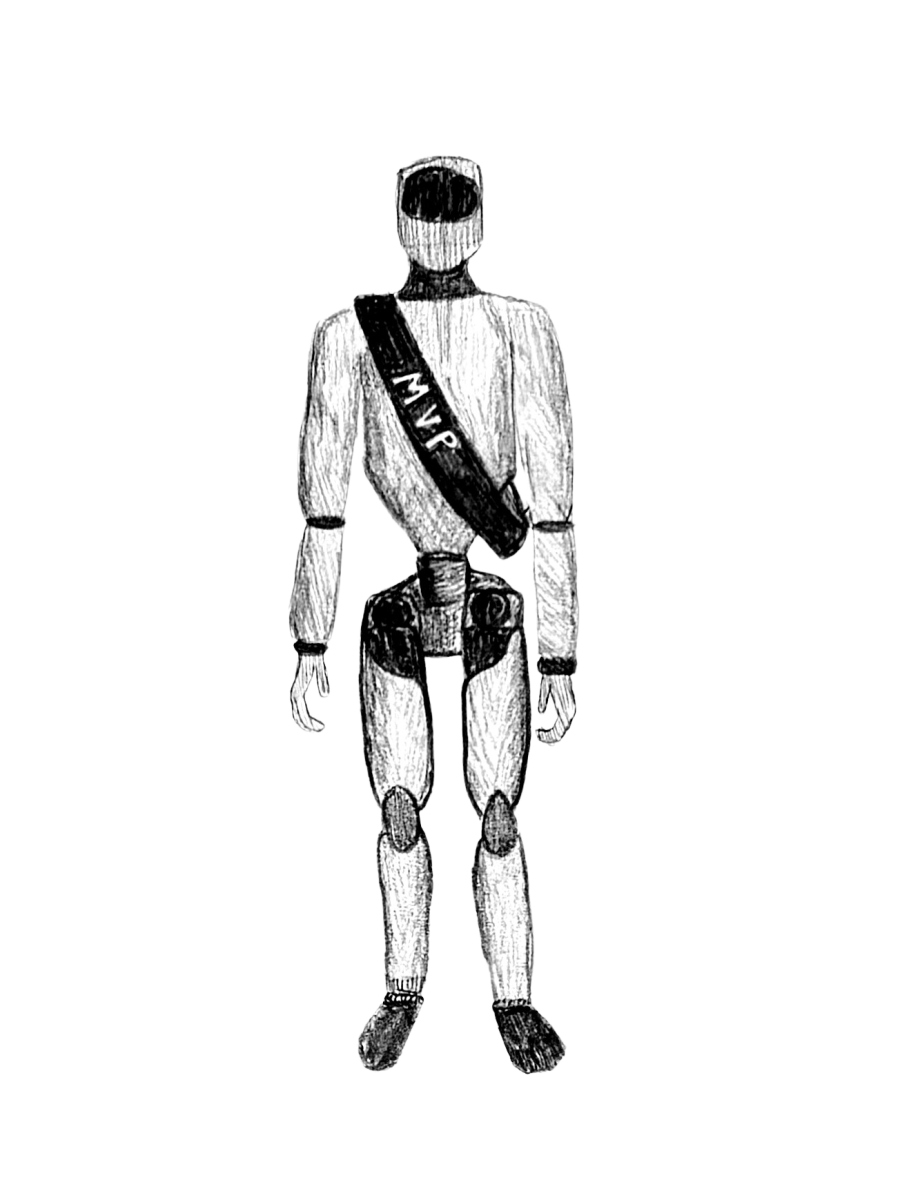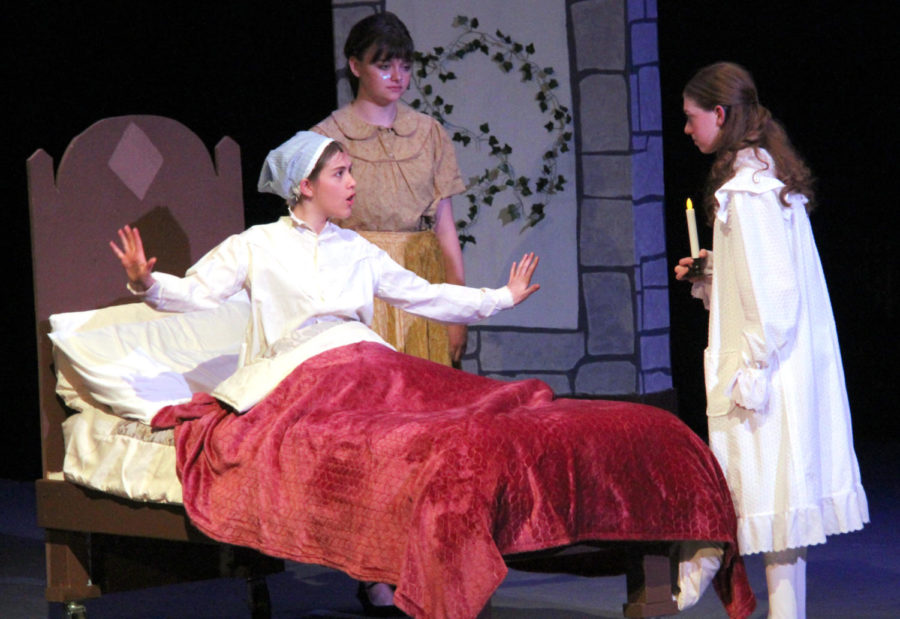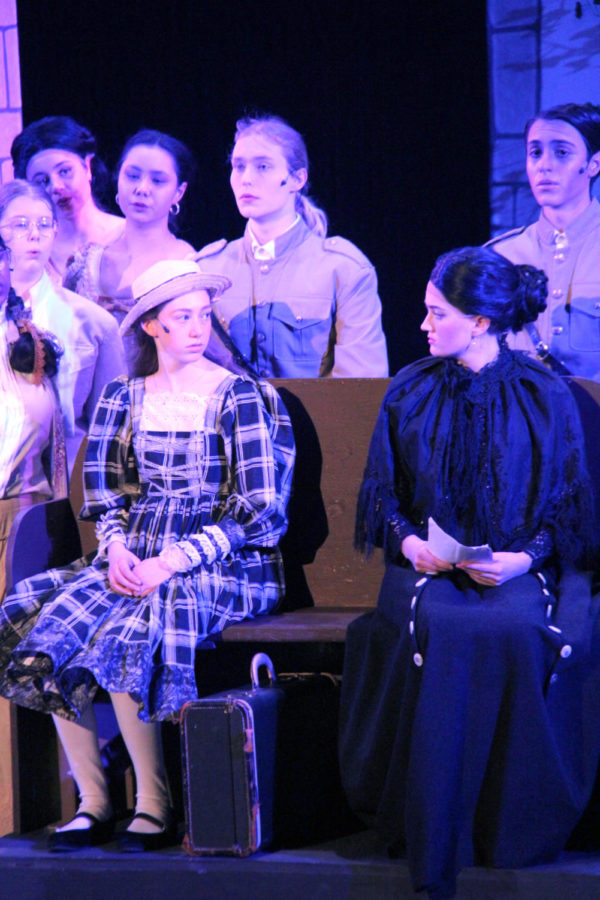‘Secret Garden’ shows talent and dedication of students and staff
Corrine Iacobucci (10), Sophie Nash (11) and Anna Hoffman (10) depict the pivotal moment in which Mary meets Colin, this is one of the many touching relationships found in the show.
April 26, 2023
I’ll admit, I was initially skeptical of “The Secret Garden” as a musical. I remember the book as being slow and gloomy, with few characters, built on a melancholy atmosphere and evocative descriptions of the natural world. I wasn’t sure how well the narrative or themes could be adapted to a musical, a generally less subdued medium.
And yet, as I sat back to watch the show my doubt lessened, replaced only by feelings of awe and amazement. I was immersed, the seats of the auditorium a distant memory, replaced by the lush greenery and complex characters of Misselthwaite manor. It felt magical.
Setting the Stage
What many people, myself included, fail to recognize is that the magic of theatre isn’t magic at all, it’s months of hard work. It’s weeks of personal time, lost to perfect every last detail. It’s individuals working hard in pursuit of a greater good. While challenges arrive with every production, this show was put on under especially extenuating circumstances.
Without the oversight of the director initially intended to helm this production, the cast and crew had to get creative. Many people stepped up, taking on larger leadership roles and responsibilities. The choreographer, Eia Waltzer, became the director and choreographer, joined by Indira Rampersad.
As well as being the older sister of cast member Izzy Rampersad, she took on the jobs assistant director, accent coach, and dramaturg. While juggling multiple roles was likely very challenging, both rose to the challenge. They put on a stunning show and received appreciation and acclaim from those who worked with them. Other leaders included choir director, Courtney Rowley, as the vocal coach and the band director, Jay Gillespie, as the instrumental director.
Students also played a major role in the execution and success of the show. Many reported that Max Moses, the stage manager, did a remarkable job. The production staff is large, the equipment delicate, and the tasks intricate. And yet, the crew managed it all, going above and beyond to create a complex set with seamless transitions. The whole production staff, from the makeup artist, to the lighting technician, to the backstage grips, diligently ensured everything ran smoothly.
The Story
“The Secret Garden” is a classic, a dark but optimistic tale about the power of life spurred by the bratty Mary Lennox, played by Anna Hoffman. The show begins in India, amidst a cholera outbreak, which kills Mary’s parents and the only life she’s ever known. Mary is then taken to Misselthwaite manor, to live with her Uncle Archibald Craven, played by Milo Palmer, on the dreary English moors.
Mary is upset to leave India behind, she has trouble adjusting to her surroundings, and is rude to those around her. The situation isn’t helped by her Uncle Archibald, a man so consumed by grief about his late wife, Lily, played by Izzy Rampersad, he can pay little attention to those who still live around him.
Through flashback sequences with Lily and her sister, Mary’s mother Rose, played by Amelia Wignall, and long heartfelt ballads between Lily and Archibald, the audience learns more about their relationships. The sisters were close, but their relationship was fraught, as Rose disapproved of Lily’s relationship with Archibald.
She married him nevertheless, bringing joy to a once unhappy man. Without her, Archibald returns to his solemnity, his lust for life dying as she did. Although she is combative and petulant, Mary would go on to fill the same role as Lily and bring joy back into the house, and back into the lives of those who reside there.
Martha, played by Ella Papineau, encourages Mary to play outside, where she meets the gardener and Martha’s brother Dickon, played by Sam Ruzumna and Elliot Jakupcake, respectively. While Mary isn’t immediately receptive to either of them, being told by the gardener, “neither of us are good looking and we’re both as sour as we look,” she goes on to warm to them.
She eventually begins to enjoy the outdoors, becoming friends with the robin who lives in the garden, and learning more about the plants. After finding the key to the walled garden, the titular Secret Garden, once beloved by Lily, Mary begins to spend her time there, rehabilitating it, in spite of the warnings.
Mary’s pattern of snooping and disobeying directions continues, when she finds Mr. Craven’s son, Colin, played by Corinne Iacobucci. Colin is a perfect counterpart to Mary, equally as bitter and haughty as she. They call each other selfish, resent each other, toss humorously morbid insults at each other, but at the end of the day they’re both just lonely children.
Both neglected by the uncle, as they remind him of his own pain. Insult her as he might, Colin is scared of losing Mary. She reassures him, saying, “I was always coming back Colin, I’m as lonely as you are.” They bicker constantly, but clearly care for each other deeply. Despite Colin’s protests, Mary believes going outside would be good for Colin.
After learning of the secret garden, Colin is intrigued and agrees to go to the garden. It is in the garden, with the support of Mary, Dickon, Martha, and the gardener, that Colin is finally able to walk. It wasn’t worry, limited freedom, or the fierce judgment of Dr. Craven that he needed. He needed Mary. He needed fresh air. He needed a friend.
While few characters are chipper or classically kind, they show their dedication and compassion for each other in other ways. The gruff gardener is sympathetic to Mary and shares stories of the garden. Uncle Archibald reads to his son while he sleeps and gives Mary the plot of earth she so desires.
Mary and Colin, rude to one another as they are, are a perfect match, and their friendship is a strong motivator for both of them. Even the overbearing and antagonistic Dr. Craven demonstrates care for his family, even though it often manifests in meddling and control.
It felt like there were no true villains, simply lonely pained people learning to cope and love each other. Mary’s relationships with those around her mirror the state of the roses in the garden. They appear harsh at first, but with some time and care the beauty and complexity that lies beneath can be revealed.
The Music
The pit orchestra, comprised of students from both band and orchestra, led by Jay Gillespie, also added subtly but beautifully to the production. Like stage crew, the musicians often go overlooked, dressed in black, and hidden from the bright gleam of the spotlight.
They too, are an integral piece of the ensemble, heightening the emotion of every scene with crescendos and descents, rising and falling notes. They also provided the sound of birds chirping. Without the pit orchestra, there would be no lovely little robin to guide the protagonist, Mary, on her way.
When combined with the vocal talents of the cast, both raucous and haunting melodies arise, invoking a myriad of emotions from the audience. The songs always served a purpose, whether it be character development or moving the plot forward.
The consistent refrain of “I Heard Someone Crying” set the mood and atmosphere of the house perfectly, the songs “Lily’s Eyes” and “How Could I Ever Know” delved into the depth of Archibald’s love for Lily, and “Come Spirit, Come Charm” provided an upbeat and catchy number to solidify the themes of community and rebirth in the show.
The Costumes
Just like the actor’s performances and the lush greenery of the set, the costumes were stunning. The chorus, who represented the group killed by cholera, all had sickly greyish yellow makeup and dressed in muted earth tones. Their distinctly light, dusty color palette served to clearly differentiate them from the rest of the cast, communicating both their ghostly nature in relation to the live characters and their connection to India and Mary’s life before she came to the moors.
The protagonist, Mary, likely had the most detailed costuming, as well as the most outfits throughout the show. She is introduced in a black plaid dress and matching hair ribbon, which she wears until she is settled at Misselthwaite and Martha begins giving her warm clothes to wear. The outfit is ramshackle, composed of a large draping jacket and a hat that falls over her eyes.
Like all aspects of her life on the moors, Mary is initially resistant to the new clothes, but comes to accept them. As the story goes on, winter fading to spring, and Mary’s haughty temper fading alongside it, she begins to wear more pastels. They look more joyful and natural than the severe tones she was initially clothed in, showing her positive evolution, spurred by her new friends and the garden.
For the costumes in this show, a lot is revealed by color. The ensemble’s colors distinguish them, Mary’s colors represent her evolution, and palette is used to denote a character’s possible moral standing. For example, both Dr. Craven and Mrs. Medlock, two antagonist figures in Mary’s story, are dressed almost all in black, which make them stand out harshly against the lighter and earthier tones worn by the rest of the cast.
Lily, the late wife of Archibald Craven, had one of my favorite costumes, a vibrant pink dress with lots of layers and floral accents. The uniquely bright and flowery tones of Lilly’s outfit in comparison to the dark and natural tones of everyone else is a reminder of spring, gardens, life, and what was left behind after her death.
I don’t know much about the historical or cultural accuracy of any costumes, but I enjoyed them nevertheless. The costuming team did a wonderful job, making the costumes visually beautiful, cohesive, and serving the larger themes and story of the show well.
Curtain Call
In many ways, the story of the production mirrors the story of “The Secret Garden.” Against the odds and despite past challenges, a group came together to create something beautiful. For Mary, it started with a dream, a hope for a little bit of earth, that flourished into something greater, but she wouldn’t have been able to do it without the guidance and support of those around her, like Martha, Dickon and the gardener.
For the production of “The Secret Garden,” it wouldn’t have been possible without the relentless dedication of the cast, crew, pit orchestra and the directors. Both the show and the story end the same way, everyone standing in the garden, surrounded by the greenery, taking in the growth and joy around them. In this way, both were a triumph of time and effort, one that reminds all who see it, just how wonderful life can be.


